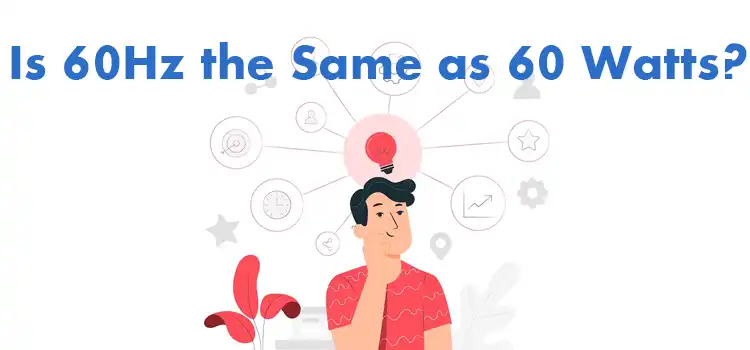Is 60Hz the Same as 60 Watts? Demystifying the Confusion
It’s important to understand the differences between two terms that are frequently used in the context of electrical appliances and power consumption: watts (W) and hertz (Hz). Despite their similarity in tone, they speak of rather different aspects of electricity. They differ in terms of real-world ramifications, power efficiency, and use of power.
The purpose of this article is to clarify any possible misunderstandings and provide readers with a thorough knowledge of the distinctions between 60 watts and 60 Hz.

Exploring the terms “Hz” and “Watts”
Before we delve into the main article we need to understand the difference between them and what they mean.
Hertz, denoted by Hz, is a unit of frequency measuring the number of cycles per second in an alternating current (AC) wave. In the context of electricity, it represents how many times a current oscillates back and forth within one second. A standard household electrical system in many countries operates at 60Hz, meaning the current changes direction 60 times per second.
Watts, on the other hand, measures the power consumed or transferred by an electrical device. It represents the rate of energy transfer or conversion per unit of time. The higher the wattage, the more power the device consumes. For instance, a 60-watt light bulb consumes energy at a rate of 60 joules per second.
Distinguishing Between 60Hz and 60 Watts
Let’s delve a bit deeper. Hertz (Hz) is a unit of frequency, named after the German physicist Heinrich Hertz. It quantifies the number of cycles or oscillations that occur in one second. In the context of electronics or signal processing, Hertz is often used to describe how quickly a signal fluctuates or how frequently a periodic event occurs.
For example, in the realm of display technology, like computer monitors or TVs, Hertz is used to indicate the refresh rate. A refresh rate of 60Hz means the image on the screen is being redrawn 60 times per second. This can impact the perceived smoothness of motion in videos or games.
Watts (W), on the other hand, measures power. Power is the rate at which energy is transferred, used, or converted. One watt is equivalent to one joule per second. This unit is named after James Watt, the Scottish engineer.
In the context of electricity, a light bulb with a power rating of 60 watts consumes 60 joules of energy every second it’s turned on. It’s a measure of how much electrical energy is being converted into light and heat.
So, in summary, Hertz measures frequency, indicating how often a cycle occurs per second, while Watts measures power, indicating the rate of energy transfer or consumption per second. They’re crucial in different domains of physics and engineering, each providing valuable information about different aspects of the phenomena being measured.
Significance in Electrical Appliances
Understanding the distinction between frequency and power consumption is crucial when selecting and using electrical appliances. Appliances designed to work in regions with different frequencies may not function correctly if used in a country with a different frequency. However, the power consumed by an appliance will depend on the wattage mentioned by the manufacturer.
Implications for Power Efficiency
While 60Hz is the standard frequency used in many countries, it does not necessarily imply that devices operating at this frequency are energy-efficient. The power consumption of an electrical device depends on its design, efficiency, and wattage rating.
Manufacturers are consistently striving to produce more energy-efficient appliances, irrespective of the frequency at which they operate.
Frequently Asked Questions
How is Watt used in everyday devices?
Wattage in devices like light bulbs indicates how much electrical power they consume. For instance, a 60-watt bulb consumes 60 joules of energy per second.
Is higher wattage always better in electronic devices?
Not necessarily. Higher wattage can mean more power consumption, but it doesn’t always equate to better performance. Efficiency and intended use also matter.
How is Hertz used in display technology?
In displays, Hertz (Hz) is the refresh rate, indicating how many times the image is redrawn per second. A higher refresh rate can contribute to smoother visuals.
To Conclude
60Hz and 60 watts are crucial measurements in electricity, but they are distinct aspects of an electrical system. 60Hz measures the frequency of electrical current, while 60 watts determines the power consumed or produced by a device. Understanding these distinctions helps users make informed decisions and avoids confusion.
Subscribe to our newsletter
& plug into
the world of circuits